
The 20 churches of Berat Castle are Eastern Orthodox churches built inside the Berat Castle. They consist of frescoes and iconostasis painted by famous Albanian icon painters such as Onufri, Kostandin Shpataraku, Zografi Brothers and more. [1]

The 20 churches of Berat Castle are Eastern Orthodox churches built inside the Berat Castle. They consist of frescoes and iconostasis painted by famous Albanian icon painters such as Onufri, Kostandin Shpataraku, Zografi Brothers and more. [1]
The castle of Berat's population was largely Christian which lead to the construction of these churches (most of them built during the 13th Century). The churches of the fortress were damaged or destroyed through years and only some have remained. They are a symbol of the castles history.


The frescoes from these churches are painted during the Middle Ages by multiple icon artists such as Onufuri who is famous in Albania and has his iconography museum located in the city of Berat.

Antiphonitis – more correctly the Church of Christ Antiphonitis – is a domed church in Cyprus, in Kyrenia District, located in the mountains near the village of Kalograia. It is reached from the network of tracks and small roads in the area of the Herbarium and Agios Amvrosios. It is under the de facto control of Northern Cyprus.
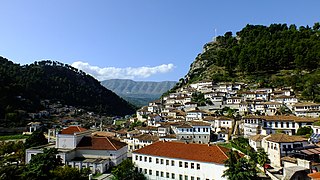
Berat is the ninth most populous city of Albania and the seat of Berat County and Berat Municipality. By air, it is 71 kilometres north of Gjirokastër, 70 kilometres west of Korçë, 70 kilometres south of Tirana, and 33 kilometres east of Fier. Berat is located in the south of the country. It is surrounded by mountains and hills, including Tomorr on the east that was declared a national park. The river Osum runs through the city before it empties into the Seman within the Myzeqe Plain. The municipality of Berat was formed at the 2015 local government reform by the merger of the former municipalities Berat, Otllak, Roshnik, Sinjë, and Velabisht, that became municipal units. The seat of the municipality is the city Berat. The total population is 62,232 as of the 2023 census, in a total area of 421.6 km2 (162.8 sq mi).

Berat County, officially the County of Berat, is a county in the Southern Region of the Republic of Albania. It is the ninth largest by area and the ninth most populous of the twelve counties, with around 140,956 people within an area of 1,798 km2 (694 sq mi). The county borders the counties of Elbasan to the north, Korçë to the east, Gjirokastër to the south and Fier to the west. It is divided into five municipalities, Berat, Dimal, Kuçovë, Poliçan and Skrapar, with all of whom incorporate twenty-five administrative units.

Onufri, Onouphrios of Neokastro or Onouphrios Argytes, was a 16th century Archpriest of Elbasan and the most important painter of Orthodox murals and icons in the early post-Byzantine era in Albania. He founded a school of painting in Berat and extended his influence as far afield as Kastoria. Trained in Venice, he infused Albanian icon painting with the artistic climate of the Italian Renaissance. His works reveal a great degree of originality and ecclesiastically combined post-Byzantine and Gothic elements. Onufri's works played a decisive role in the following trends of Albanian art, up to the 19th century.

Gramsh is a town and a municipality in Elbasan County, central Albania. The municipality was formed at the 2015 local government reform by the merger of the former municipalities Gramsh, Kodovjat, Kukur, Kushovë, Lenie, Pishaj, Poroçan, Skënderbegas, Sult and Tunjë, that became municipal units. The seat of the municipality is the town Gramsh. The total population is 16,533 as of the 2011 census, in a total area of 739.75 km2. The population of the former municipality as of the 2023 census is 6,786.

The Church of St Constantine and Helena is a church in Plovdiv, Bulgaria. It is considered to be among the oldest churches in the city. It was built in 337 at the sight of an ancient pagan temple in the acropolis on one of the fortified hills. The church was named after Emperor Constantine the Great and his mother Elena. During the years, the building was destroyed and rebuilt several times. Its current edifice was constructed in 1832 with the help of local patriots. Its magnificent frescoes and icons were painted by masters of one of the most famous Bulgarian Icongraphic Schools: the Debar School. Some of the icons and painting of the church were made by the famous Bulgarian National Revival painter Zahari Zograf who lived and worked in Plovdiv between 1836 and 1840.
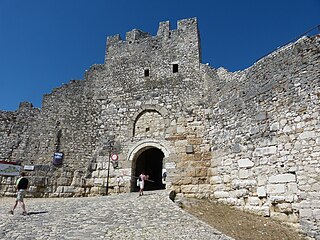
Berat Castle, also referred to as the Citadel of Berat and castle quarter, is a fortress overlooking the town of Berat, Albania. It dates mainly from the 13th century and contains many Byzantine churches in the area and Ottoman mosques. It is built on a rocky hill on the right bank of the river Osum and is accessible only from the south. It is situated at an elevation of 214 metres (702 ft).
The Historic Centres of Berat and Gjirokastër encompasses the cities of Berat and Gjirokastër in southern Albania. Gjirokastër was added to the UNESCO World Heritage Site list in 2005 while Berat was added as a site extension in 2008. They are inscribed as rare examples of an architectural character typical of the Ottoman period.

The Monastery of the Nativity of the Theotokos in Ardenica (Albanian: Manastiri Lindja e Hyjlindëses Mari,; or simply Ardenica Monastery is an Albanian Orthodox monastery, located 18 kilometers south of Lushnjë, Albania, along the national road that links Lushnjë to Fier.

The St. Mary of Blachernae Church is a Byzantine-era Albanian Orthodox church in Berat, Albania. It is named after the famous Church of St. Mary of Blachernae, near the Palace of Blachernae in Constantinople. It is believed that the church was built on the foundations of a ruined 5th century church that existed at the same place. The church is regarded as one of Berat's most important historical and architectural monuments and is a key tourist attraction for both Berat and Albania.
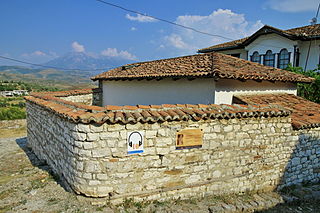
St. Theodore's Church is an Orthodox church in Berat Castle, Berat, Albania. It became a Cultural Monument of Albania in 1948. It is one of the 20 Churches of Berat Castle.
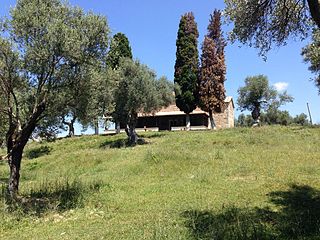
St. Paraskevi's Church is a church in Çetë, Kavajë Municipality, Albania. It became a Cultural Monument of Albania in 1963.

The St. Michael's Church is a medieval Byzantine-era Albanian Orthodox Church outside the Kalaja district on a hilltop of the city of Berat of Southern Albania. As part of the Historic Centres of Berat and Gjirokastër UNESCO World Heritage Site, the church was possibly constructed in the fourteenth century and is dedicated to the archangel Michael.

Kostandin Shpataraku, also commonly known as Shpataraku, was an Albanian Orthodox icon and fresco painter of the Post-Byzantine period in the eighteenth century. He continued to combine Byzantine tradition with influences from the Renaissance. He is regarded as one of the most prominent figures of medieval Albanian art besides Onufri and David Selenica.

The architecture of Albania is a reflection of Albania's historical and cultural heritage. The country's architecture was influenced by its location within the Mediterranean Basin and progressed over the course of history as it was once inhabited by numerous civilisations including the Illyrians, Ancient Greeks, Romans, Byzantines, Venetians, Ottomans as well as modern Austro-Hungarians and Italians. In addition, missionaries, invaders, colonisers and traders brought cultural changes that had a large profound effect on building styles as well as techniques.

The Onufri Iconographic Museum is an Albanian national museum dedicated to Byzantine art and iconography in Berat, Albania. The museum is located inside the Church of the Dormition of St Mary in the castle quarter Berat. The museum was named to honor Onufri, a painting Headmaster of the 16th century.
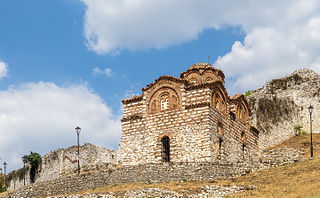
The tourist attractions in Berat refers to the tourist attractions in Berat. The city of Berat is a city in the south of the Republic of Albania and the capital of the surrounding Berat County. It offers a variety of tourist attractions, including historical sights, monuments, museums, theatres, churches, monasteries, mosques and places.

Vokopola is a village in the south of Berat County in the Dimal municipality in Albania.

The Cultural heritage of Albania is a blend of ancient traditions and historical influences that come together in Albania to create a rich mosaic of culture and history.

Stoya Muzaka, also known as Stoja, was an Albanian nobleman, the Lord of Kastoria, and a member of the influential Albanian Muzaka family, which played a significant role in ruling parts of Southern Albania and Epirus.